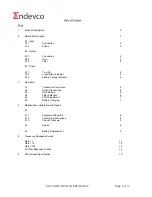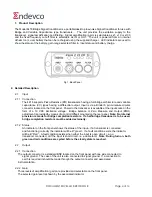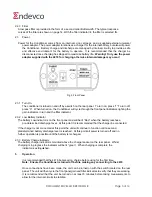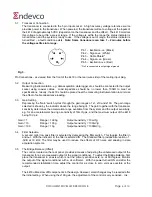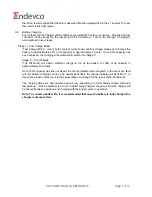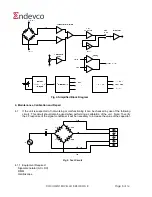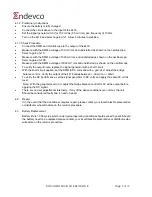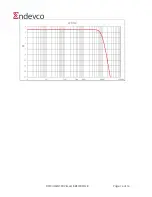
DOCUMENT EDVIM4418 REVISION B
Page 6 of 14
3.1 Transducer
Connection
The transducer is connected to the 5 pin input socket. A high accuracy voltage reference source
provides power to the transducer. When powered, the transducer will set a voltage at the inputs of
the 4418 of approximately 5VDC
(dependent on the transducer and the offset). The 4418 monitors
this voltage to be within a pre-set range. If the voltage is within the range the status indicator is
turned Green and the system is ready to use. If the voltage is out of range, the status indicator is
turned Red – a fault condition exists.
Note: Some transducers can take 1 – 2 minutes before
the voltage settles into range.
Fig
3.
Pin Connections - as viewed from the front of the 4418 or the rear (wire side) of the mating input plug.
3.2 Output
Connection
Measuring Instrumentation, e.g. data acquisition, data logger etc. should be connected to the output
socket using coaxial cables. Load impedance should be no lower than 100k
Ω
to meet all
specifications. Ideally, the 4418 should be placed near the measuring instrumentation to minimize
the effect of cable capacitance loading.
3.3 Gain
Setting
Depressing the “Gain” switch cycles through the gain ranges of x1, x10 and x100. The gain range
selected is shown by the indicator above the range being lit. The gain together with the transducer
sensitivity determines the acceleration range available from the system and the output sensitivity,
e.g. for an accelerometer having a sensitivity of 10mV/g pk, and the maximum output of the 4418
being 10V pk:
Gain = 1
Range = 1000g
Output sensitivity = 10mV/g
Gain = 10
Range = 100g
Output sensitivity = 100mV/g
Gain = 100
Range = 10g
Output sensitivity = 1000mV/g
3.4 Filter
Selection
A second order low pass filter is selected by depressing the filter switch. This toggles the filter in
and out. With the indicator lit, the filter is selected IN. The Standard filter provides attenuation of
-3dB at 10 kHz. The filter maybe used to reduce the effects of HF noise and aliasing in data
acquisition systems.
3.5
The Bridge Balance (Offset)
The control, located on the rear panel, provides a means of adjusting the unbalanced output of the
transducer for a zero measured output of the signal conditioner. To adjust the Bridge Balance, first
place the transducer in an axis which is not the primary sensitive axis, i.e. at 90 degrees. Monitor
the output of the signal conditioner with a dc voltmeter. With the power turned ON and after the
recommended stabilization time, adjust the control for as close to zero volts as possible at the
output.
The 4418 utilizes low drift components in the design. However, small changes may be required after
the initial setting. When using the x100 gain, the adjustment of the control is very sensitive. It is,
Pin 1 – Excitation
-
ve (
Black
)
Pin 2 – Signal
-
ve (
White
)
Pin 3 –
Cable Shield*
Pin 4 – Signal
+
ve (
Green
)
Pin 5 – Excitation
+ve
(
Red
)
*Pin 3 is connected to output signal ground.
Summary of Contents for 4418
Page 1: ...DOCUMENT EDVIM4418 REVISION B Page 1 of 14 Instruction Manual 4418 Bridge Signal Conditioner ...
Page 10: ...DOCUMENT EDVIM4418 REVISION B Page 10 of 14 This page is Left intentionally blank ...
Page 11: ...DOCUMENT EDVIM4418 REVISION B Page 11 of 14 TYPICAL FREQUENCY RESPONSE CURVES ...
Page 12: ...DOCUMENT EDVIM4418 REVISION B Page 12 of 14 ...



